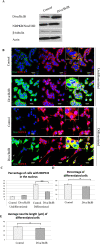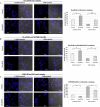Diva/BclB regulates differentiation by inhibiting NDPKB/Nm23H2-mediated neuronal differentiation in PC-12 cells
- PMID: 23057762
- PMCID: PMC3564942
- DOI: 10.1186/1471-2202-13-123
Diva/BclB regulates differentiation by inhibiting NDPKB/Nm23H2-mediated neuronal differentiation in PC-12 cells
Abstract
Background: Diva (death inducer binding to vBcl-2 and Apaf-1)/BclB is a Bcl-2 family member, which is known for its function in apoptosis. Diva/BclB has been shown to interact with NDPKB/Nm23H2, which is involved in cellular differentiation. Thus far, there has been no direct evidence of Diva/BclB having a role in differentiation. In the present study, we investigated the expression of Diva/BclB and NDPKB/Nm23H2 during differentiation in PC-12 cell line.
Results: Our results show that after differentiation, Diva/BclB expression was decreased and reciprocally, NDPKB/Nm23H2 expression was increased and it translocated into the nucleus. Overexpression of NDPKB/Nm23H2 promoted PC-12 neuronal differentiation by increasing neurite outgrowth and arresting cell cycle progression. There was a concurrent downregulation of Diva/Boo when NDPKB/Nm23H2 was overexpressed, which mirrors the effect of NGF on PC-12 cell differentiation. Overexpression of Diva/BclB did not change the expression level of NDPKB/Nm23H2, but inhibited its nuclear localization. Cells that overexpressed Diva/BclB presented a decreased percentage of differentiated cells and average neurite length was shortened. This was due to an increase in the formation of Diva/BclB and NDPKB/Nm23H2 complexes as well as Diva/BclB and β-tubulin complexes. Concomitantly, there was a decrease in formation of NDPKB/Nm23H2 and β-tubulin complexes. Overexpression of Diva/BclB also resulted in a higher percentage of S-phase cells.
Conclusion: Our results showed a novel role for Diva/BclB in neuronal differentiation. Its downregulation during neuronal differentiation may be necessary to allow NDPKB/Nm23H2 and β-tubulin interaction that promotes NDPKB/Nm23H2 mediated differentiation.
Figures





Similar articles
-
NM23-H2 involves in negative regulation of Diva and Bcl2L10 in apoptosis signaling.Biochem Biophys Res Commun. 2007 Jul 20;359(1):76-82. doi: 10.1016/j.bbrc.2007.05.090. Epub 2007 May 24. Biochem Biophys Res Commun. 2007. PMID: 17532299
-
nm23 influences proliferation and differentiation of PC12 cells in response to nerve growth factor.Cell Growth Differ. 1996 Dec;7(12):1689-95. Cell Growth Differ. 1996. PMID: 8959337
-
Nm23-M2/NDP kinase B induces endogenous c-myc and nm23-M1/NDP kinase A overexpression in BAF3 cells. Both NDP kinases protect the cells from oxidative stress-induced death.Exp Cell Res. 2004 Dec 10;301(2):293-304. doi: 10.1016/j.yexcr.2004.07.026. Exp Cell Res. 2004. PMID: 15530864
-
Interplay between the antimetastatic nm23 and the retinoblastoma-related Rb2/p130 genes in promoting neuronal differentiation of PC12 cells.Cell Death Differ. 2001 May;8(5):470-6. doi: 10.1038/sj.cdd.4400842. Cell Death Differ. 2001. PMID: 11423907
-
FoxO3a negatively regulates nerve growth factor-induced neuronal differentiation through inhibiting the expression of neurochondrin in PC12 cells.Mol Neurobiol. 2013 Feb;47(1):24-36. doi: 10.1007/s12035-012-8357-7. Epub 2012 Oct 21. Mol Neurobiol. 2013. PMID: 23086522
Cited by
-
Apaf1-deficient cortical neurons exhibit defects in axonal outgrowth.Cell Mol Life Sci. 2015 Nov;72(21):4173-91. doi: 10.1007/s00018-015-1927-x. Epub 2015 May 15. Cell Mol Life Sci. 2015. PMID: 25975226 Free PMC article.
-
NME1 Drives Expansion of Melanoma Cells with Enhanced Tumor Growth and Metastatic Properties.Mol Cancer Res. 2019 Aug;17(8):1665-1674. doi: 10.1158/1541-7786.MCR-18-0019. Epub 2019 May 23. Mol Cancer Res. 2019. PMID: 31123173 Free PMC article.
-
Three-Dimensional Cell Drawing Technique in Hydrogel Using Micro Injection System.Micromachines (Basel). 2022 Oct 30;13(11):1866. doi: 10.3390/mi13111866. Micromachines (Basel). 2022. PMID: 36363885 Free PMC article.
-
Long Noncoding RNA LINC00261 Reduces Proliferation and Migration of Breast Cancer Cells via the NME1-EMT Pathway.Cancer Manag Res. 2020 May 4;12:3081-3089. doi: 10.2147/CMAR.S237197. eCollection 2020. Cancer Manag Res. 2020. PMID: 32440206 Free PMC article.
-
Regulatory functions of Nm23-H2 in tumorigenesis: insights from biochemical to clinical perspectives.Naunyn Schmiedebergs Arch Pharmacol. 2015 Feb;388(2):243-56. doi: 10.1007/s00210-014-1066-1. Epub 2014 Nov 21. Naunyn Schmiedebergs Arch Pharmacol. 2015. PMID: 25413836 Review.
References
-
- Vaudry D, Storkk PJS, Lazarovici P, Eiden E. Signaling Pathways for PC12 Cell Differentiation: Making the Right Connections. Science. 2002;276:1648–1649. - PubMed
-
- Cho SA, Seo MJ, Ko JY, Shim JH, Yoo J, Kim JH, Kim SY, Ryu NK, Park EY, Lee HW, Lee YS, Bahk YY, Park JH. Up-regulation of Idh3 α causes reduction of neuronal differentiation in PC12 cells. Biochemistry and Molecular Biology Reports. 2010;43:369–374. - PubMed
Publication types
MeSH terms
Substances
LinkOut - more resources
Full Text Sources
Research Materials

